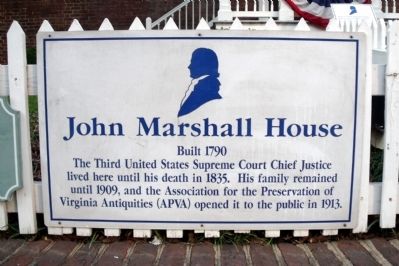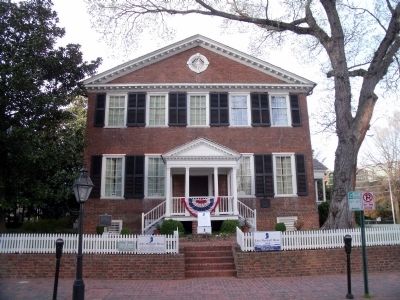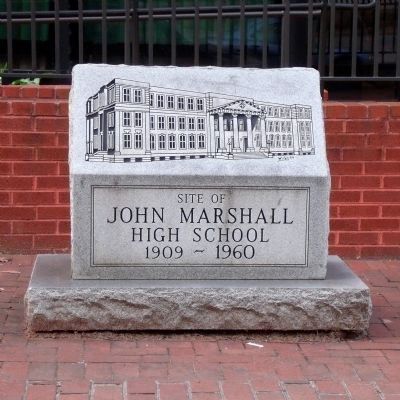Capitol District in Richmond, Virginia — The American South (Mid-Atlantic)
John Marshall House
Built 1790
Erected by APVA-Preservation Virginia.
Topics. This historical marker is listed in this topic list: Government & Politics. A significant historical year for this entry is 1835.
Location. This marker has been replaced by another marker nearby. It was located near 37° 32.511′ N, 77° 25.992′ W. Marker was in Richmond, Virginia. It was in the Capitol District. Marker was at the intersection of East Marshall Street and North 9th Street on East Marshall Street. Touch for map. Marker was at or near this postal address: 818 East Marshall Street, Richmond VA 23219, United States of America. Touch for directions.
Other nearby markers. At least 8 other markers are within walking distance of this location. A different marker also named The John Marshall House (here, next to this marker); The Residence of John Marshall (a few steps from this marker); John Marshall Corps of Cadets (a few steps from this marker); a different marker also named The John Marshall House (within shouting distance of this marker); The Richmond Female Institute / Woman's College of Richmond (about 500 feet away, measured in a direct line); The Murphy Hotel (about 500 feet away); The Edward V. Valentine Sculpture Studio (about 600 feet away); Valentine Museum (about 600 feet away). Touch for a list and map of all markers in Richmond.
More about this marker. An identical marker is in the rear of the house.
Related marker. Click here for another marker that is related to this marker. This marker has been replaced with the linked marker.
Also see . . .
1. The John Marshall House. Preservation Virginia (Submitted on March 31, 2010.)
2. John Marshall. Library of Virginia (Submitted on March 31, 2010.)
3. John Marshall House. National Register of Historic Places (Submitted on November 13, 2021.)
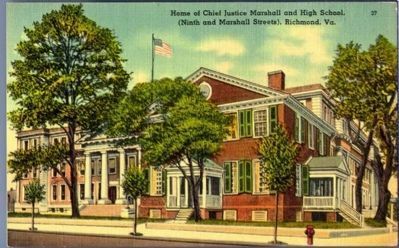
Photographed By Louis Kaufmann & Sons, Baltimore, MD., circa 109
4. Home of Chief Justice Marshall (9th and Marshall Street), Richmond, Va.
One of the most interesting landmarks in the City is the old Marshall home, built by the great Chief Justice and occupied by him from 1795 until his death in 1835. Tho' [sic] the spacious grounds which once surrounded this old Colonial residence have been greatly reduced in area, the building itself retains its original appearance. In 1913 it was acquired by the Assn. For Preservation of Va. Antiquities as the permanent home of this organization. No more venerable and historical relic, of such general interest to all Americans is to be found in the South. Occupying a part of the same square is Richmond's splendid new high school. VCU Libraries Digital Collections - Rarely Seen Richmond
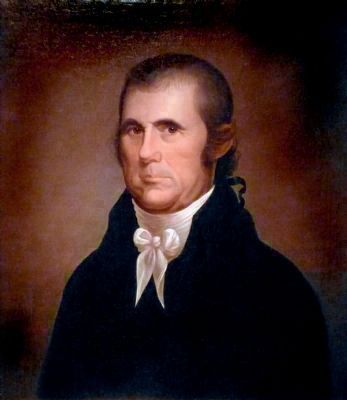
Photographed By Allen C. Browne, January 18, 2014
5. John Marshall
This 1809–10 portrait of John Marshall by Cephus Thompson hangs in the National Portrait Gallery in Washington DC.
“John Marshall, the fourth chief justice of the United States, established the concept of judicial review — in which the Supreme Court could pronounce a law of Congress as unconstitutional — and strengthened the idea of an independent federal judiciary. In cases brought to the Court between 1810 and 1824 — years in which the Marshall Court enjoyed great stability and harmony — Marshall used the Court's judicial review to nullify state laws violating constitutional restraints of state power. The effect of Marshall's long tenure as chief justice (1801-35) was to strengthen the Court, the Constitution, and the federal government. The Court became a preeminent interpreter of the Constitution, and the federal government's enumerated powers were given a broad interpretation and made superior to those of the states.
Cephas Thompson painted a portrait of Marshall from life in Richmond, as well as six replicas for admirers, two years after Marshall presided at the trial of Aaron Burr for treason.” — National Portrait Gallery
“John Marshall, the fourth chief justice of the United States, established the concept of judicial review — in which the Supreme Court could pronounce a law of Congress as unconstitutional — and strengthened the idea of an independent federal judiciary. In cases brought to the Court between 1810 and 1824 — years in which the Marshall Court enjoyed great stability and harmony — Marshall used the Court's judicial review to nullify state laws violating constitutional restraints of state power. The effect of Marshall's long tenure as chief justice (1801-35) was to strengthen the Court, the Constitution, and the federal government. The Court became a preeminent interpreter of the Constitution, and the federal government's enumerated powers were given a broad interpretation and made superior to those of the states.
Cephas Thompson painted a portrait of Marshall from life in Richmond, as well as six replicas for admirers, two years after Marshall presided at the trial of Aaron Burr for treason.” — National Portrait Gallery
Credits. This page was last revised on February 19, 2023. It was originally submitted on March 31, 2010, by Bernard Fisher of Richmond, Virginia. This page has been viewed 905 times since then and 12 times this year. Photos: 1, 2, 3. submitted on March 31, 2010, by Bernard Fisher of Richmond, Virginia. 4. submitted on May 10, 2012, by Bernard Fisher of Richmond, Virginia. 5. submitted on July 15, 2015, by Allen C. Browne of Silver Spring, Maryland.
